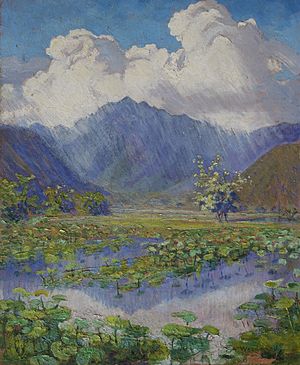Anna Woodward facts for kids
Anna Woodward (1868–1935) was an American painter. She was born in Pittsburgh, Pennsylvania in 1868. Anna studied painting in Paris at the Académie Julian, a famous art school. She also learned from artists like Tony Robert-Fleury, Jules Joseph Lefebvre, and William-Adolphe Bouguereau. Later, she studied with George Hitchcock in Holland.
By 1918, Anna moved to Hawaii from Paris. She had a studio near Waikiki. She was inspired by the Impressionist art style, which focuses on capturing light and atmosphere. She created many beautiful landscape paintings. In the 1920s and 1930s, her illustrations and paintings were featured in the magazine Paradise of the Pacific. Anna Woodward passed away in Honolulu, Hawaii, in 1935. Her artwork can be found in public collections, including the University of Iowa Museum of Art.
Contents
About Anna Woodward
Anna Woodward was born in Pittsburgh, Pennsylvania, on January 26, 1868. Her father, Marcus A. Woodward, was a well-known lawyer. Anna grew up in Pennsylvania and earned a bachelor's degree.
Early Life and Art Training
Soon after her studies, Anna traveled to Paris with her mother. There, she enrolled at the Académie Julian, a famous art school. She focused on oil painting. She learned from important teachers like Jules-Joseph LeFebvre, Tony Robert-Fleury, and William Bourguereau.
During the summers, Anna attended a special art school in Holland. This school was led by George Hitchcock, another artist. From 1890 to 1915, Anna and many other students joined Hitchcock at his private studio in Egmond aan den Hoef.
Becoming a Known Artist
While living in Paris, Anna Woodward became well-known. She showed her paintings in many art exhibitions and galleries. In 1898, her art was accepted into the famous Paris Salon. She showed two paintings: Le sabot casse (created in France) and Recolte des pommes de terre (created in Holland). In 1903, she won a silver medal at the Reims Exposition Internationale.
Anna was part of the American art community in Paris. She also joined the Union des Femmes Peintres et Sculpteurs. This group was started by Helene Bertaux to help female artists gain recognition. Anna was also a member of the Pittsburgh Art Association early in her life. Later, she joined the Hawaiian Academy of the Arts, where she often displayed her work.
Life in Hawaii
Anna Woodward lived in Paris during World War I. After the war, she was advised to move to a warmer place for her health. So, she traveled to Africa and then to Hawaii. In 1918, she settled in the Waikiki area. She became a respected artist in Hawaii's wealthy and artistic communities. Many people asked her to paint special artworks for them.
Her paintings have been shown in many galleries across the United States and France. This includes the Carnegie Institute in Pittsburgh, Pennsylvania. She exhibited there in 1909. She also showed her art in local Hawaiian galleries and the Honolulu Academy of Arts. Her paintings often showed the beauty of the Hawaiian Islands. Some of her famous Hawaiian works include A Honolulu Garden, Manoa Valley, and The Dunes.
In early 1935, The State University of Iowa displayed Anna's painting, The Dunes. This painting was part of an exhibit featuring works by famous artists. Today, The Dunes is kept at the University of Iowa Museum of Art.
Writing and Legacy
Anna Woodward also wrote articles for local magazines and newspapers in Hawaii. She wrote about art, reviewed local exhibitions, and shared her thoughts on Hawaii as an artistic inspiration. Her artwork was used in the magazine Paradise in the Pacific throughout the 1920s and 1930s. She is especially known for her writings about her time in the art communities of Paris and Holland, titled “Art Life in France and Holland.”
Anna Woodward passed away in Honolulu, Hawaii, on July 12, 1935, at age 67. Her remains were brought back to Pittsburgh and laid to rest at the Homewood Cemetery. Her artworks are still displayed in galleries and museums, and some are sold at auctions today.


